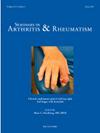Disease activity predicts the development of cardiovascular events in patients with rheumatoid arthritis from the CARMA cohort
IF 4.4
2区 医学
Q1 RHEUMATOLOGY
引用次数: 0
Abstract
Objective
To identify significant predictors of cardiovascular (CV) events in rheumatoid arthritis (RA) patients from the CARdiovascular in RheuMAtology (CARMA) project, followed prospectively for 10 years.
Methods
Between July 2010 and January 2012, 708 RA patients were recruited from 67 hospitals across Spain. The study focused on patients with no prior CV events at the time of recruitment. At the 10-year follow-up, data on the occurrence of CV events, patient-years of follow-up and linearized event rates were analyzed. Cox regression analyses were conducted, both crude and adjusted for PREVENT-CVD.
Results
Over 6608 patient-years, 114 patients (16.1%) experienced CV events, yielding a linearized event rate of 1.73 per 100 patient-years. Patients with CV events were older (70.7± 10.6 vs. 62.1±12.8 years, p<0.001), more frequently male (36.0% vs. 20.0%, p<0.001), and had higher rates of hypertension (46.5% vs. 23.4%, p<0.001), diabetes (14% vs. 4.9%, p=0.001), and dyslipidemia (37.7% vs. 27.4%, p=0.03). Higher baseline erythrocyte sedimentation rate (ESR) was also associated with future CV events. Those who developed CV events had a significantly higher predicted 10-year CV risk using the PREVENT-CVD score (18.0% vs. 10.3%, p<0.001). Cox regression analysis adjusted for PREVENT-CVD showed that although higher crude C-reactive protein and uric acid levels were associated with increased CV risk, after adjustment these associations weakened and became non-significant. However, higher disease activity (DAS28-ESR) was linked to greater CV risk, with moderate/high disease activity (DAS28-ESR>3.2) showing a significantly higher adjusted CV risk (HR 1.62; 95% CI: 1.06–22.47, p=0.03).
Conclusions
Disease activity is a key determinant of CV outcomes in RA patients. The PREVENT-CVD score is an effective tool for CV risk stratification in this population.
CARMA队列研究中,疾病活动性预测类风湿关节炎患者心血管事件的发展
目的从风湿病学心血管(CARMA)项目中确定类风湿关节炎(RA)患者心血管(CV)事件的重要预测因素,前瞻性随访10年。方法2010年7月至2012年1月,从西班牙67家医院招募708名RA患者。该研究的重点是在招募时没有既往CV事件的患者。在10年随访中,分析了CV事件发生、随访患者年数和线性化事件发生率的数据。对prevention - cvd进行了原始和调整后的Cox回归分析。结果在6608例患者-年中,114例患者(16.1%)经历了CV事件,线性化事件发生率为1.73 / 100例患者-年。发生CV事件的患者年龄较大(70.7±10.6岁vs. 62.1±12.8岁,p=0.001),男性较多(36.0% vs. 20.0%, p=0.001),高血压(46.5% vs. 23.4%, p=0.001)、糖尿病(14% vs. 4.9%, p=0.001)和血脂异常(37.7% vs. 27.4%, p=0.03)的发生率较高。较高的基线红细胞沉降率(ESR)也与未来的心血管事件相关。使用prevention - cvd评分,发生CV事件的患者预测10年CV风险显著较高(18.0% vs 10.3%, p<0.001)。校正prevention - cvd后的Cox回归分析显示,尽管较高的粗c反应蛋白和尿酸水平与CV风险增加相关,但校正后这些关联减弱并变得不显著。然而,较高的疾病活动度(DAS28-ESR)与较高的CV风险相关,中等/高疾病活动度(DAS28-ESR>3.2)显示出较高的调整后CV风险(HR 1.62; 95% CI: 1.06-22.47, p=0.03)。结论疾病活动性是类风湿关节炎患者心血管预后的关键决定因素。prevention - cvd评分是该人群心血管风险分层的有效工具。
本文章由计算机程序翻译,如有差异,请以英文原文为准。
求助全文
约1分钟内获得全文
求助全文
来源期刊
CiteScore
9.20
自引率
4.00%
发文量
176
审稿时长
46 days
期刊介绍:
Seminars in Arthritis and Rheumatism provides access to the highest-quality clinical, therapeutic and translational research about arthritis, rheumatology and musculoskeletal disorders that affect the joints and connective tissue. Each bimonthly issue includes articles giving you the latest diagnostic criteria, consensus statements, systematic reviews and meta-analyses as well as clinical and translational research studies. Read this journal for the latest groundbreaking research and to gain insights from scientists and clinicians on the management and treatment of musculoskeletal and autoimmune rheumatologic diseases. The journal is of interest to rheumatologists, orthopedic surgeons, internal medicine physicians, immunologists and specialists in bone and mineral metabolism.

 求助内容:
求助内容: 应助结果提醒方式:
应助结果提醒方式:


